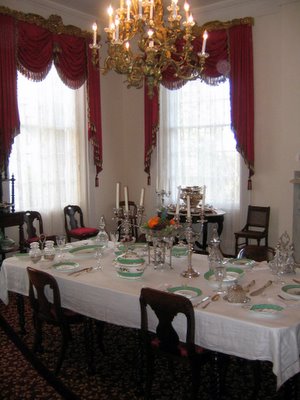November 22, 2005
Fall Pilgrimage part one

The Mighty Mississippi from the park of the mansion "Rosalie" Natchez MS

The Beautiful "Rosalie" Family Home that survived five political overlords, fire, war and plauge. The French, British and Spanish used the bluff the home was built on as a fort.
Fort Rosalie, named for a French Countess is a National Historic Place
The Double Parlours, Mens on one side and Ladies on the other. Divided by pocket doors, The Ladies Parlour was larger (it took more space for them to move around) and often had a Piano or other musical instrument for evening entertainment. All furniture is original and the house and grounds are maintained by the Daughters of the American Revolution.
The Rosalie is one of the most beautiful Antebellum homes in existance

Rosalie is a magnificent example of the Federal Style of architecture and is one of Natchez’s stately antebellum mansions. It is owned and operated by the Mississippi State Society Daughters of the American Revolution, who purchased the house in 1938. It is situated on a high bluff overlooking the Mississippi River. This site was chosen by the French for the first settlement on the river in 1716 and was named "Fort Rosalie" in honor of the lovely Duchess de Pontchartrain.
Rosalie was built by Peter Little, 1820-1823, and designed by his brother-in-law, James S. Griffin, who came to Natchez from Baltimore. Peter Little was born in Pittsburgh, Pennsylvania in 1781 and came to Natchez near the end of that century. Peter found an old boat in the river and from it developed the Steam Circular saw which was the beginning of the lumber business in the area. Peter soon saw the possibilities in the vast tracts of timber lands which lay across the river. It was in timber that he made his fortune and established the first sawmill in the Natchez Territory.

In 1806 Peter Little married Eliza Lowe, the daughter of Mr. and Mrs. Jacob Lowe. It was for Eliza that Peter built Rosalie. The materials for the house were of local cypress and imported mahogany, cut in his own sawmill. The woodwork throughout the entire house is hand carved by slave labor. The very best materials went into the building of the mansion.
Unfortunately, Mr. Little died without a legal will, and the house was sold at public auction to the Andrew Wilson Family in 1857. All of the furnishings were disbursed and very few things were left to remind us of the Peter Little years.
Upon purchase by Andrew Wilson, fine furnishings were purchased for the house from both New York and Europe. Mrs. Wilson and her adopted daughter, Fannie, traveled to New York and purchased the magnificent Rosalie Belter furniture, 20 pieces in all. To this day, this represents one of the finest complete sets of John Henry Belter furniture in America. The furniture is made of Rosewood.

During the War Between the States, Rosalie was occupied by the Union Troops. General Walter Gresham, a gentleman, had the furniture and fragile pieces taken to the attic and locked away . The twin mirrors with handsome gold-leaf frames came from France and were taken down by the Wilsons, wrapped in blankets and protected between bales of cotton in an old cave in the Old Fort area. These mirrors have never been refinished in any way and are in splendid condition today. The Dining Room was the only room damaged during the War. Union soldiers used it as their mess hall, cooking in the fireplace. The stains and cracks in the marble are still visible today.
Rosalie never had an indoor kitchen. It was located in the two-story brick dependency building behind of the house. All food was prepared in an old fashioned fireplace, then carried in covered dishes through the latticed passage, and handed to dining room servants through the window. That kitchen has been restored to its historical condition and is on tour now.
At the time Rosalie was purchased by the Mississippi State Society Daughters of the American Revolution in 1938, descendants of the Wilson family were still living in the house. That was part of the agreement to sell, that the family would be allowed to live there until their death.
Through the years the Mississippi Daughters of the American Revolution have lovingly restored their Rosalie and shared both the mansion and its gardens with the public in full knowledge of how perfectly and graciously Rosalie captures the culture of bygone days....
........A Time Remembered

The kitchen
